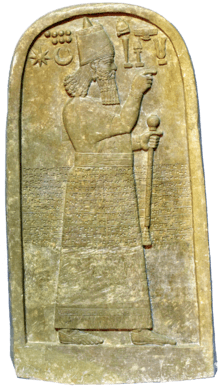Adad-nirari III
Adad-nirari III (also Adad-narari) was a King of Assyria from 811 to 783 BC.
| Adad-nirari III | |
|---|---|
| King of Assyria | |
 The Tell al-Rimah Stele was discovered in 1967 and commemorates Adad-nirari III’s campaigns in the West.[1] | |
| King of the Neo-Assyrian Empire | |
| Reign | 811–783 BC |
| Predecessor | Shamshi-Adad V |
| Successor | Shalmaneser IV |
| Issue | Ashur-nirari V Shalmaneser IV Ashur-dan III Tiglath-Pileser III? |
| Father | Shamshi-Adad V |
| Mother | Shammuramat |
Family
Adad-nirari was a son and successor of king Shamshi-Adad V, and was apparently quite young at the time of his accession, because for the first five years of his reign, his mother Shammuramat[2] was highly influential, which has given rise to the legend of Semiramis.[3]
It is widely rejected that his mother acted as regent, but she was surprisingly influential for the time period.[4]
He was the father of kings Ashur-nirari V, Shalmaneser IV, and Ashur-dan III. Tiglath-Pileser III described himself as a son of Adad-nirari in his inscriptions, but it is uncertain if this is true.
Biography
Adad-nirari's youth, and the struggles his father had faced early in his reign, caused a serious weakening for the Assyrian rulership over Mesopotamia, and gave way to the ambitions of the most officers, governors, and the local rulers.
According to Adad-nirari's inscriptions, he led several military campaigns with the purpose of regaining the strength Assyria enjoyed in the times of his grandfather Shalmaneser III.
According to the eponym canon, he campaigned in all directions until the last of his 18 years of reign (783 BC), and he was the builder of the temple of Nabu at Nineveh. Among his actions was a siege of Damascus in the time of Ben-Hadad III in 796 BC, which led to the eclipse of the Aramaean Kingdom of Damascus and allowed the recovery of Israel under Jehoash (who paid the Assyrian king tribute at this time) and Jeroboam II.
Despite Adad-nirari's vigour, Assyria entered a several-decades-long period of weakness following his death.
See also
References
- Tell Al Rimah Stele, IM 70543, in the Iraq Museum, Baghdad.
- Georges Roux: Ancient Iraq, Penguin Books, London 1992, ISBN 0-14-012523-X, page 302.
- Reilly, Jim (2000) "Contestants for Syrian Domination" in "Chapter 3: Assyrian & Hittite Synchronisms" The Genealogy of Ashakhet Archived 2012-03-11 at the Wayback Machine;
- Ancient Near Eastern History and Culture by William H. Stiebing Jr.
| Preceded by Shamshi-Adad V |
King of Assyria 811–783 BC |
Succeeded by Shalmaneser IV |